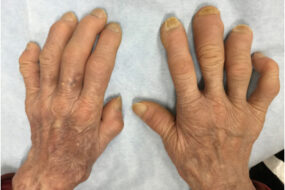- Home
- INTERNAL MEDICINE
- Rheumatology
- Felty syndrome

Felty syndrome is a rare and severe form of rheumatoid arthritis (RA) characterized by the classic triad of rheumatoid arthritis, splenomegaly (enlarged spleen), and neutropenia (low levels of neutrophils, a type of white blood cell). It is associated with chronic, severe seropositive RA and occurs in less than 1% of RA patients.
Pathophysiology
The exact cause of Felty syndrome is not well understood, but it is thought to involve a combination of genetic, immunologic, and environmental factors. Key mechanisms include:
- Autoimmune Activity: Felty syndrome is an autoimmune disorder where the immune system attacks healthy tissues, causing systemic inflammation.
- Neutropenia: This is likely due to a combination of splenic sequestration and immune-mediated destruction of neutrophils.
- Splenomegaly: Chronic inflammation in RA can lead to an enlarged spleen, which sequesters white blood cells, reducing their circulating numbers.
- Genetic Predisposition: Certain HLA-DR4 subtypes have been linked with an increased risk of Felty syndrome, suggesting a genetic component.
Risk Factors
- Rheumatoid Arthritis Duration: Patients with long-standing RA (typically more than 10 years) and severe joint involvement are at higher risk.
- Seropositive RA: Higher titers of rheumatoid factor (RF) and anti-cyclic citrullinated peptide (anti-CCP) antibodies increase the likelihood of Felty syndrome.
- Genetics: HLA-DRB1 alleles are strongly associated with Felty syndrome.
Clinical Features
Patients with Felty syndrome often present with:
- Rheumatoid Arthritis Symptoms: Chronic, symmetric polyarthritis affecting small and large joints, morning stiffness, joint swelling, and deformities.
- Splenomegaly: An enlarged spleen may be asymptomatic or cause a sensation of fullness or discomfort in the left upper abdomen.
- Neutropenia: Low neutrophil counts increase susceptibility to bacterial infections, especially respiratory tract infections, skin infections, and sepsis.
- Other Systemic Manifestations:
- Hepatomegaly: Enlarged liver may be present.
- Lymphadenopathy: Swollen lymph nodes.
- Skin Manifestations: May include leg ulcers, hyperpigmentation, and vasculitis.
- Anemia and Thrombocytopenia: Occasionally accompany neutropenia.
Diagnostic Approach
The diagnosis of Felty syndrome is primarily clinical, supported by laboratory tests and imaging. Key steps include:
- Clinical History and Physical Examination: Evaluate the history of RA, signs of splenomegaly, and symptoms suggestive of neutropenia or infections.
- Laboratory Tests:
- Complete Blood Count (CBC): Reveals neutropenia, anemia, or thrombocytopenia.
- Rheumatoid Factor (RF) and Anti-CCP Antibodies: High levels support the diagnosis.
- Antinuclear Antibodies (ANA): May be positive in some cases.
- Inflammatory Markers: Elevated erythrocyte sedimentation rate (ESR) and C-reactive protein (CRP).
- Imaging:
- Ultrasound or CT Scan of the Abdomen: To confirm splenomegaly.
- Joint X-rays: May show characteristic RA changes, such as joint space narrowing, erosions, and osteopenia.
Differential Diagnosis
Several conditions can mimic Felty syndrome and should be considered:
- Large Granular Lymphocyte (LGL) Leukemia: Can present with neutropenia and splenomegaly in RA patients.
- Systemic Lupus Erythematosus (SLE): May present with similar hematological findings.
- Chronic Liver Disease: Can also cause splenomegaly and cytopenias.
- Primary Bone Marrow Disorders: Such as aplastic anemia or myelodysplastic syndromes.
Management
The treatment of Felty syndrome focuses on managing RA, controlling infections, and addressing neutropenia:
- Disease-Modifying Antirheumatic Drugs (DMARDs):
- Methotrexate: Commonly used as the first-line therapy to control RA and improve neutropenia.
- Leflunomide, Hydroxychloroquine, and Sulfasalazine: May be considered if methotrexate is not suitable.
- Biologic Agents:
- TNF-α Inhibitors (e.g., etanercept, infliximab): Effective in treating both RA and neutropenia.
- Rituximab: May be useful in cases refractory to other treatments.
- Glucocorticoids: Prednisone can be used for short-term management of severe symptoms.
- Granulocyte Colony-Stimulating Factor (G-CSF): Used to increase neutrophil count in patients with severe or recurrent infections.
- Splenectomy: Rarely performed but may be considered in refractory cases with severe, life-threatening neutropenia.
- Antibiotics: Empirical therapy for suspected bacterial infections, particularly in cases of febrile neutropenia.
Prognosis
With appropriate management, the prognosis of Felty syndrome is generally favorable, although patients remain at increased risk of infections due to chronic neutropenia. Disease activity of RA and complications associated with chronic therapy can impact the overall outcome.
Monitoring and Follow-up
- Regular CBC Monitoring: To track neutrophil counts and adjust therapy as needed.
- RA Activity Assessment: Routine evaluation of joint symptoms and inflammatory markers.
- Infection Surveillance: Early recognition and treatment of infections are crucial.












